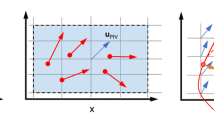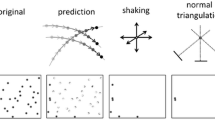Abstract
A novel method performing 3D PTV from double-frame multi-camera images is introduced. Particle velocities are estimated by following three steps: First, separate particle reconstructions with a sparsity based algorithm are performed on a fine grid. Second, they are expanded on a coarser grid on which 3D correlation is performed, yielding a predictor displacement field that allows to efficiently match particles at the two time instants. As these particles are still located on a voxel grid, the third, final step achieves particle position refinement to their actual subvoxel position by a global optimization process, also accounting for their intensities. As it strongly leverages on principles from tomographic reconstruction, the technique is termed Double-Frame Tomo-PTV (DF-TPTV). Standard synthetic tests on a complex turbulent flow show that the method achieves high particle and vector detection efficiency, up to seeding densities of around 0.08 particles per pixel (ppp). On these tests, it also shows a higher robustness to noise and lower root-mean-square errors on velocity estimation than similar state-of-the-art methods. Results from an experimental campaign on a transitional round air jet at Reynolds number 4600 are also presented. Average seeding density varies in time from 0.06 to 0.03 ppp during the considered run, with different densities and signal-to-noise ratios being observed with time in the jet and ambient air regions, supplied by two different seeding systems. The strong polydisperse nature of the seeding, as well as the coexistence of two spatial zones of significantly different particle densities and signal-to-noise ratios, are observed to be the most influential sources of limitation for DF-TPTV performance. However, the method still successfully reconstructs a large amount of particles, and, associated with an outlier rejection scheme based on temporal statistics, truthfully reconstructs the instantaneous jet dynamics. Further quantitative performance assessment is then provided by introducing statistics performed by bin averaging, upon assuming statistical axisymmetry of the jet. Mean and fluctuating axial velocity components in the jet near-field are compared with reference results obtained from planar PIV at higher seeding density, with an interrogation window of size comparable to that of the bins. Results are found to be in excellent agreement with one another, confirming the high performance of DF-TPTV to yield reliable volumetric vector fields at seeding densities usually considered for tomographic PIV processing.
























Similar content being viewed by others
Notes
We used the L-BFGS implementation of Stewart, available at http://www.cs.toronto.edu/~liam/software.shtml.
References
Agüera N, Cafiero G, Astarita T, Discetti S (2016) Ensemble 3D PTV for high resolution turbulent statistics. Meas Sci Technol 27(12):124011
Atkinson C, Soria J (2009) An efficient simultaneous reconstruction technique for tomographic particle image velocimetry. Exp Fluids 47:553–568
Champagnat F, Plyer A, Le Besnerais G, Leclaire B, Davoust S, Le Sant Y (2011) Fast and accurate PIV computation using highly parallel iterative correlation maximization. Exp Fluids 50:1169–1182
Champagnat F, Cornic P, Cheminet A, Leclaire B, Le Besnerais G, Plyer A (2014) Tomographic PIV: particles versus blobs. Meas Sci Technol 25(8):084002
Cheminet A, Leclaire B, Champagnat F, Plyer A, Yegavian R, Le Besnerais G (2014) Accuracy assessment of a Lucas–Kanade based correlation method for 3D PIV. In: 17th international symposium on applications of laser techniques to fluid mechanics, Lisbon, Portugal
Cornic P, Champagnat F, Plyer A, Leclaire B, Cheminet A, Le Besnerais G (2014) Tomo-PTV with sparse tomographic reconstruction and optical flow. In: 17th international symposium on applications of laser techniques to fluid mechanics, Lisbon, Portugal
Cornic P, Champagnat F, Cheminet A, Leclaire B, Le Besnerais G (2015a) Fast and efficient particle reconstruction on a 3D grid using sparsity. Exp Fluids 56(3):62
Cornic P, Leclaire B, Cheminet A, Champagnat F, Losfeld G, Illoul C, Le Sant Y, Plyer A, Le Besnerais G (2015b) Two time steps tomo-PTV with sparse tomographic reconstruction versus tomo-PIV. In: 11th international symposium on PIV - PIV15, Santa Barbara, USA
Cornic P, Illoul C, Cheminet A, Le Besnerais G, Champagnat F, Le Sant Y, Leclaire B (2016) Another look at volume self-calibration: calibration and self-calibration within a pinhole model of scheimpflug cameras. Meas Sci Technol 27:9
Elsinga GE, Scarano F, Wieneke B, van Oudheusden BW (2006) Tomographic particle image velocimetry. Exp Fluids 41(6):933–947
Fuchs T, Hain R, Kähler CJ (2016) Double-frame 3D-PTV using a tomographic predictor. Exp Fluids 57(11):174
Graham J, Kanov K, Yang XIA, Lee M, Malaya N, Lalescu CC, Burns R, Eyink G, Szalay A, Moser RD, Meneveau C (2016) A web services accessible database of turbulent channel flow and its use for testing a new integral wall model for LES. J Turbul 17(2):181–215
Griffin J, Schultz T, Holman R, Ukeiley LS, Cattafesta L (2010) Application of multivariate outlier detection to fluid velocity measurements. Exp Fluids 49(4):305–317
Jux C, Sciacchitano A, Schneiders JFG, Scarano F (2018) Robotic volumetric PIV of a full-scale cyclist. Exp Fluids 59(4):74
Kähler C, Astarita T, Vlachos P, Sakakibara J, Hain R, Discetti S, La Foy R, Cierpka C (2016) Main results of the 4th international PIV challenge. Exp Fluids 57(6):97
Li Y, Perlman E, Wan M, Yang Y, Meneveau C, Burns R, Chen S, Szalay A, Eyink G (2008) A public turbulence database cluster and applications to study lagrangian evolution of velocity increments in turbulence. J Turbul 9:N31
Maas HG, Gruen A, Papantoniou D (1993) Particle tracking velocimetry in three-dimensional flows. Part 1. Photogrammetric determination of particle coordinates. Exp Fluids 15:133–146
Malik NA, Dracos T, Papantoniou DA (1993) Particle tracking velocimetry in three-dimensional flows. Exp Fluids 15(4):279–294
Needell D, Tropp JA (2009) CoSaMP: iterative signal recovery from incomplete and inaccurate samples. Appl Comput Harmon Anal 26:301–321
Nishino K, Kasagi N, Hirata M (1989) Three-dimensional particle tracking velocimetry based on automated digital image processing. J Fluids Eng 111(4):384–391
Nocedal J, Wright S (2006) Numerical optimization, 2nd edn. Springer, Berlin
Novara M, Schanz D, Reuther N, Kähler CJ, Schröder A (2016) Lagrangian 3D particle tracking in high-speed flows: shake-the-box for multi-pulse systems. Exp Fluids 57(8):128
Park J, Kihm K (2006) Three-dimensional micro-ptv using deconvolution microscopy. Exp Fluids 40(3):491
Scarano F (2012) Tomographic PIV: principles and practice. Meas Sci Technol 24(1):012001
Schanz D, Gesemann S, Schröder A (2016) Shake-the-box: Lagrangian particle tracking at high particle image densities. Exp Fluids 2016:57–70
Schröder A, Geisler R, Sieverling A, Wieneke B, Henning A, Elsinga G, Scarano F, Poelma C (2009) Lagrangian aspects of coherent structures in a turbulent boundary layer flow using TR-tomo PIV and PTV. In: 8th international symposium on particle image velocimetry—PIV09, Melbourne
Schröder A, Geisler R, Staack K, Elsinga G, Scarano F, Wieneke B, Henning A, Poelma C, Westerweel J (2011) Eulerian and Lagrangian views of a turbulent boundary layer flow using time-resolved tomographic PIV. Exp Fluids 50(4):1071–1091
Warner S, Smith B (2014) Autocorrelation-based estimate of particle image density for diffraction limited particle images. Meas Sci Technol 25(6):065201
Wieneke B (2013) Iterative reconstruction of volumetric particle distribution. Meas Sci Technol 24(2):024008
Willert C, Gharib M (1992) Three-dimensional particle imaging with a single camera. Exp Fluids 12(6):353–358
Author information
Authors and Affiliations
Corresponding author
Additional information
Publisher's Note
Springer Nature remains neutral with regard to jurisdictional claims in published maps and institutional affiliations.
Rights and permissions
About this article
Cite this article
Cornic, P., Leclaire, B., Champagnat, F. et al. Double-frame tomographic PTV at high seeding densities. Exp Fluids 61, 23 (2020). https://doi.org/10.1007/s00348-019-2859-2
Received:
Revised:
Accepted:
Published:
DOI: https://doi.org/10.1007/s00348-019-2859-2




